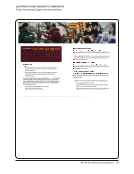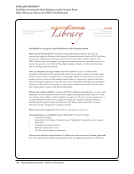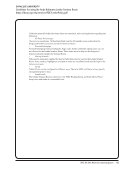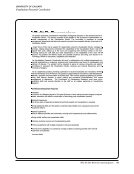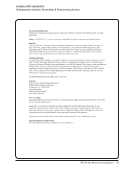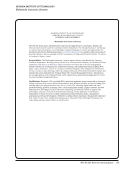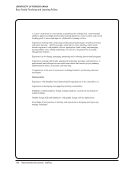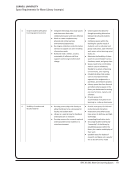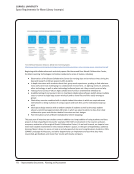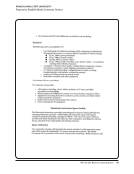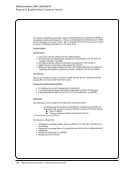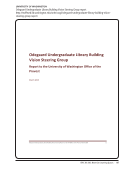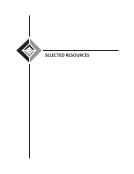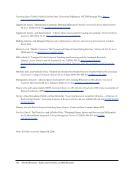74 · Survey Results: Survey Questions and Responses
Instructional Program: In partnership with the US Naval ROTC program at the university, the library provides a space
for a naval training simulation classroom. The simulator is in the Creativity Studio, an open, flexible space in which the
furniture can be arranged to approximate the actual layout of a vessel’s bridge with a massive floor-to-ceiling curved
screen to serve as the immersive forward view from the ship. The Creativity Studio is a white-box space that can be
easily reconfigured and transformed. It has high-definition, 3D-capable projectors, movable and writable walls, a full
theater lighting kit, and many interactive tools. Library IT staff worked closely with the Navy software development
team to test and adapt the application for use in the Creativity Studio. Success is measured by feedback from the
faculty and students in the Naval ROTC program. The commanding officer of the North Carolina Piedmont Regions
said that, “[the library] was able to create an MSS lab that goes well beyond the functions of the basic product.... This
particular MSS package has been turned into a full mission bridge simulator, second only to those located in major fleet
concentration areas.”
Introduction to Applied Marketing class with embedded library instruction via Blackboard, LibGuides, video tutorials,
and workshops. Assessment is measured via the grading of a portion of the final project, number of students in each
workshop, types of questions asked, and number of visits to each page of the LibGuide.
Library Essentials, a program done in collaboration with English 100, utilizes two librarians and reaches about 80% of
English 100 classes. Instruction is done in a classroom with computers and flip charts. Student surveys and feedback
from faculty are used to assess the program.
Library Open House makes use of the entire 1st floor of the main library. Students are introduced to key services
&resources show-and-tell style with handouts, giveaways, and demonstrations (e.g., of multimedia equipment &
inventory of collections). A cross-section of staff &librarians are involved from all libraries. Grand prize drawing is
tied to survey to assess what students learned at the Open House event and feedback that is used to plan for the
following year.
Library West, the Science Library, and Health Science Center Library collaborated on a simultaneous information
literacy event held across all three branches and embedded into a campus-wide augmented reality game, Humans
vs. Zombies. Librarians &IT staff were involved in collaboration with the HvZ student group. HSCL used large screen
monitors and specialized anatomy software, Library West and the Science Library used classrooms for “create spaces”
and coordinated information scavenger hunts for participants to gather clues to win points in the game. Success was
measured by participation.
Night in the Library had 1000+ students in attendance. Activities held in all parts of the building. Some of the events
were related to library services or collections but most were entertainment-oriented and designed to get them in
to different areas of the building. Success was primarily measured by size of the turnout. No formal assessment
was conducted.
One librarian in one of our multimedia classrooms uses the open-ended response system, Poll Everywhere, twice during
instruction sessions to solicit responses from students about the affective domain. The students are surveyed once
at the beginning and once at the end of the class. The poll questions are designed to measure students’ confidence
levels in finding sources for their assignments. Poll Everywhere is a web service that provides instructors with a flexible
response system with several modes of participation, including text messaging with multiple-choice questions using
a pre- and post-class format. Before and after the class, students are asked to anonymously respond to the question
ranking their confidence level to see if their feelings and attitudes related to the research process, which is essential to
their growth as lifelong learners. It has also been found that the sessions have a positive influence on affective learning
with regard to the trait of confidence.
Instructional Program: In partnership with the US Naval ROTC program at the university, the library provides a space
for a naval training simulation classroom. The simulator is in the Creativity Studio, an open, flexible space in which the
furniture can be arranged to approximate the actual layout of a vessel’s bridge with a massive floor-to-ceiling curved
screen to serve as the immersive forward view from the ship. The Creativity Studio is a white-box space that can be
easily reconfigured and transformed. It has high-definition, 3D-capable projectors, movable and writable walls, a full
theater lighting kit, and many interactive tools. Library IT staff worked closely with the Navy software development
team to test and adapt the application for use in the Creativity Studio. Success is measured by feedback from the
faculty and students in the Naval ROTC program. The commanding officer of the North Carolina Piedmont Regions
said that, “[the library] was able to create an MSS lab that goes well beyond the functions of the basic product.... This
particular MSS package has been turned into a full mission bridge simulator, second only to those located in major fleet
concentration areas.”
Introduction to Applied Marketing class with embedded library instruction via Blackboard, LibGuides, video tutorials,
and workshops. Assessment is measured via the grading of a portion of the final project, number of students in each
workshop, types of questions asked, and number of visits to each page of the LibGuide.
Library Essentials, a program done in collaboration with English 100, utilizes two librarians and reaches about 80% of
English 100 classes. Instruction is done in a classroom with computers and flip charts. Student surveys and feedback
from faculty are used to assess the program.
Library Open House makes use of the entire 1st floor of the main library. Students are introduced to key services
&resources show-and-tell style with handouts, giveaways, and demonstrations (e.g., of multimedia equipment &
inventory of collections). A cross-section of staff &librarians are involved from all libraries. Grand prize drawing is
tied to survey to assess what students learned at the Open House event and feedback that is used to plan for the
following year.
Library West, the Science Library, and Health Science Center Library collaborated on a simultaneous information
literacy event held across all three branches and embedded into a campus-wide augmented reality game, Humans
vs. Zombies. Librarians &IT staff were involved in collaboration with the HvZ student group. HSCL used large screen
monitors and specialized anatomy software, Library West and the Science Library used classrooms for “create spaces”
and coordinated information scavenger hunts for participants to gather clues to win points in the game. Success was
measured by participation.
Night in the Library had 1000+ students in attendance. Activities held in all parts of the building. Some of the events
were related to library services or collections but most were entertainment-oriented and designed to get them in
to different areas of the building. Success was primarily measured by size of the turnout. No formal assessment
was conducted.
One librarian in one of our multimedia classrooms uses the open-ended response system, Poll Everywhere, twice during
instruction sessions to solicit responses from students about the affective domain. The students are surveyed once
at the beginning and once at the end of the class. The poll questions are designed to measure students’ confidence
levels in finding sources for their assignments. Poll Everywhere is a web service that provides instructors with a flexible
response system with several modes of participation, including text messaging with multiple-choice questions using
a pre- and post-class format. Before and after the class, students are asked to anonymously respond to the question
ranking their confidence level to see if their feelings and attitudes related to the research process, which is essential to
their growth as lifelong learners. It has also been found that the sessions have a positive influence on affective learning
with regard to the trait of confidence.









































































































































